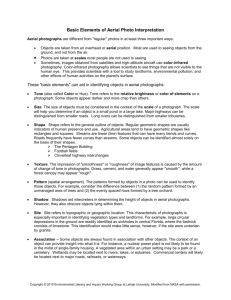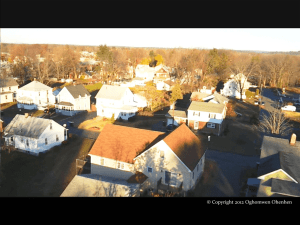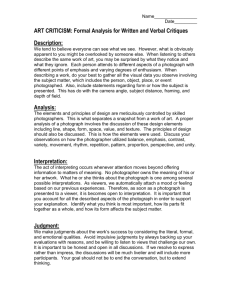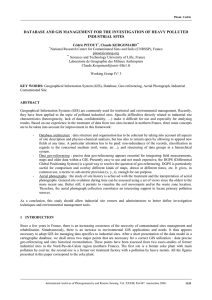Aerial photography
advertisement
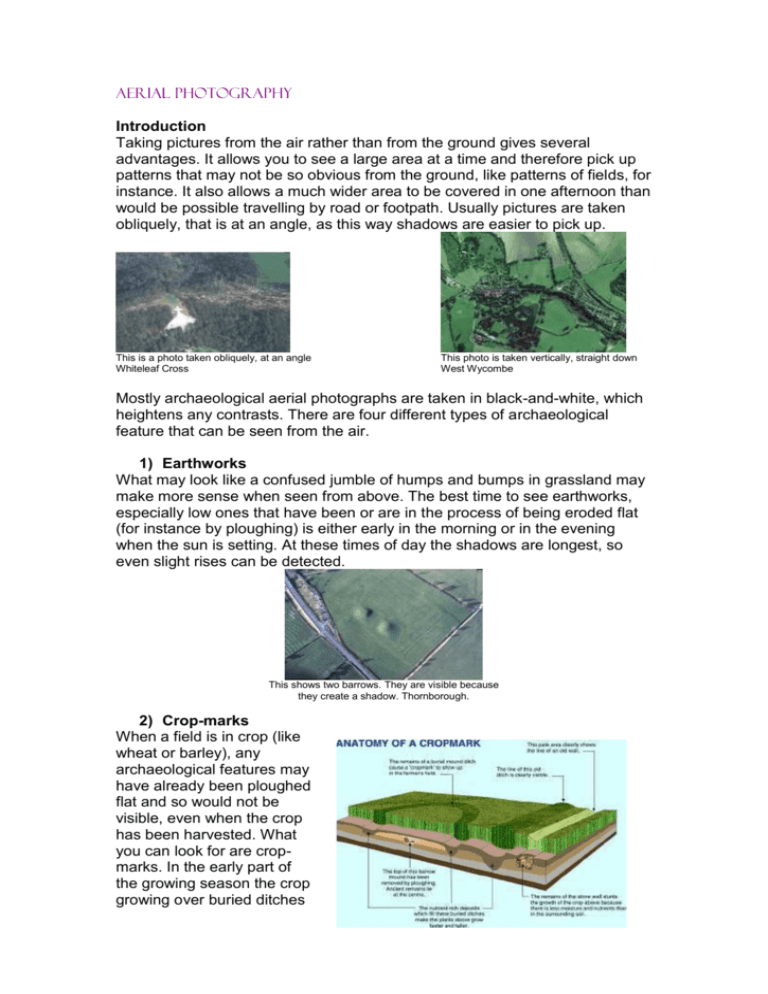
Aerial photography Introduction Taking pictures from the air rather than from the ground gives several advantages. It allows you to see a large area at a time and therefore pick up patterns that may not be so obvious from the ground, like patterns of fields, for instance. It also allows a much wider area to be covered in one afternoon than would be possible travelling by road or footpath. Usually pictures are taken obliquely, that is at an angle, as this way shadows are easier to pick up. This is a photo taken obliquely, at an angle Whiteleaf Cross This photo is taken vertically, straight down West Wycombe Mostly archaeological aerial photographs are taken in black-and-white, which heightens any contrasts. There are four different types of archaeological feature that can be seen from the air. 1) Earthworks What may look like a confused jumble of humps and bumps in grassland may make more sense when seen from above. The best time to see earthworks, especially low ones that have been or are in the process of being eroded flat (for instance by ploughing) is either early in the morning or in the evening when the sun is setting. At these times of day the shadows are longest, so even slight rises can be detected. This shows two barrows. They are visible because they create a shadow. Thornborough. 2) Crop-marks When a field is in crop (like wheat or barley), any archaeological features may have already been ploughed flat and so would not be visible, even when the crop has been harvested. What you can look for are cropmarks. In the early part of the growing season the crop growing over buried ditches grows and ripens quicker, because the soil in ditches is looser and holds more moisture. On the other hand, if the crop is over buried walls or roads the crop grows and ripens slower, so the crop over walls and roads is shorter and yellower than surrounding plants. You can see crop-marks in the morning or evening, similarly to earthworks. 3) Parch-marks You can sometimes see the remains of walls, roads and other hard surfaces in parch-marks in grass, if the summer has been hot enough. Just like with crop-marks, buried stone blocks grass roots and they can’t get enough moisture to survive. You have to look for these at the end of the summer. Parch-marks of Luffield Priory at Silverstone 4) Soil-marks If you fly over a field between harvest and planting when there is no crop you may be able to see soil-marks. Buried ditches not only tend to have looser soil, but it is often a different colour. This is because if ditches are left open for many years they eventually silt up with windblown material from elsewhere and not the same soil that has been dug out to construct the ditches. Sometimes the remains of ploughed out mounds or banks can also be detected, especially if the underlying rock is chalk. You will see a spread, a line or a ring of white in the dark soil. Soilmarks of a circular enclosure, several rectangular enclosures and pits etc… Parsonage Down, Wiltshire What to look for The kinds of features that are definitely man-made have very definite edges and appear to form geometric shapes. Sometimes it is difficult to know when something has been made by human action in the past and when something is due to modern agriculture or even caused by natural and geological events, such as silted up river channels or frost cracking of the underlying bedrock. Have a look at the English Heritage website and their aerial photography section for more information. A common error is to mistake an “envelope” arrangement in a field as an archaeological feature, when it is really down to agricultural techniques. Find a picture with the envelope feature on and put it here. Agricultural marks can also make it difficult to see what’s underneath. Can you see a rectangular enclosure on this photograph of a field outside Water Stratford? It is masked by the straight lines the tractors make when they fertilise and spray pesticides on the fields. Now you know what to look for on aerial photographs, here are a few for you to investigate. You get one mark for each correct answer. Quarrendon Is this an oblique or a vertical aerial photograph? What kind of archaeological feature/s can you see (circle one)? a) Earthwork b) Crop-mark c) Soil-mark d) Parch-mark What do you think these features are the remains of? Cheddington Is this an oblique or a vertical aerial photograph? What kind of feature/s can you see? b) Earthwork b) Crop-mark c) Soil-mark d) Parch-mark What do you think the features are remains of? Can you see the modern features? Haddenham Is this an oblique or a vertical aerial photograph? What kind of feature/s can you see? c) Earthwork b) Crop-mark c) Soil-mark d) Parch-mark What do you think the features are remains of? Can you tell which features are made by natural processes? Ludgershall Is this an oblique or a vertical aerial photograph? What kind of feature/s can you see? d) Earthwork b) Crop-mark c) Soil-mark d) Parch-mark What do you think the features are remains of? Chearsley Is this an oblique or a vertical aerial photograph? What kind of feature/s can you see? e) Earthwork b) Crop-mark c) Soil-mark d) Parch-mark What do you think the features are remains of? Can you see the modern features? Once you have completed this exercise your teacher will give you a photocopy or a printout of an aerial photograph. You must decide what type of feature you can see and also decide what it might have been. Once you have done that you have to work out where the feature is on a map and draw it on. To do this you need a good picture with several field boundaries on so that you can match up the field boundaries to the map. Put stuff in here about how to plot from an aerial photograph.
